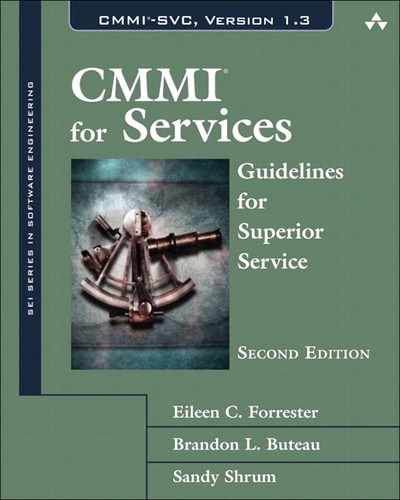Contents
PART ONE—ABOUT CMMI FOR SERVICES
Do You Have These Common Problems?
How Does CMMI Help You to Solve These Problems?
Stakeholder, Customer, and End User
Core Process Areas and CMMI Models
Required, Expected, and Informative Components
Components Associated with Part Two
Specific Goal and Practice Summaries
Supporting Informative Components
Important Roles in Process Improvement
The SCAMPI Lead Appraiser or Team Leader
The Purpose and Function of Appraisals
Finding the Right SCAMPI Lead Appraiser or Team Leader
An Approach to Getting Started
4 ACHIEVING PROCESS IMPROVEMENT THAT LASTS
Understanding Generic Practices
Understanding Capability Levels
Using Capability Levels and Maturity Levels
5 RELATIONSHIPS AMONG PROCESS AREAS
Relationships that Drive Service Establishment and Delivery
Relationships that Drive Service Management
Lifecycles in CMMI for Services
6 ESSAYS ABOUT CMMI FOR SERVICES
The Principal Agents of Change
Benchmarking: A Management Tool for Change
Expanding Capabilities across the “Constellations”
CMMI for Services, with a Dash of CMMI for Development
Implementing CMMI for Services
Enhancing Advanced Use of CMMI-DEV with CMMI-SVC Process Areas for SoS
Multiple Paths to Service Maturity
Case 1: CMMI-DEV Maturity Level to CMMI-DEV Maturity Level 3 Adapted for Services, 2004–2007
Case 2: CMM-SW to CMMI-DEV and ISO 9001
Case 3: CMM-SW to CMMI-DEV Maturity Level 3 and Maturity Level 5 to CMMI-SVC
Using CMMI-DEV and ISO 20000 Assets in Adopting CMMI-SVC
Understanding the Service Spectrum
Rethinking the Core Process Areas
Understanding Customer Relationships
Understanding the New Terminology
Understanding How to Reuse Existing CMMI Process Assets
Understanding How to Use and Reuse ISO 20000 Assets
Experience-Based Expectations for CMMI-SVC
Expectations for CMMI-SVC to Be a Promising Model
From Compliance-Driven Improvement to Performance-Driven Improvement
An IT Services Scenario Applying CMMI for Services: The Story of How HeRus Improved Its IT Services
What It Looks Like in Practice
Introduction to the HeRus Scenario
Capacity and Availability Management (CAM)
Incident Resolution and Prevention (IRP)
What We Can Learn from High-Performing IT Organizations to Stop the Madness in IT Outsourcing
Our Ten-Year Study of High-Performing IT Organizations
Common Culture Among High Performers
The Performance Differences between High and Low Performers
What Goes Wrong in Too Many IT Outsourcing Programs
An Effective System of IT Operations
Public Education in an Age of Accountability
Federal Legislation Drives Change
Orienting Education to Delivering Services
A Service Agreement for Education
A Process for Producing Consistently High Levels of Student Learning
A Process for Efficient Decision Making
Other Applications for the Model in Education
A Better Future for American Education
Applying CMMI-SVC for Educational Institutions
The Three-Step Methodological Approach
Sample Interpretation of the SD Process Area for the Educational Domain
The Limits of the Maturity Level Number
Considerations for the Responsible Buyer
Remaining Engaged after Buying
Seeking Accomplishment as Well as Capability
CMMI Ensures Vehicle Insurance Services
An Overview of the Vehicle Insurance Industry
Areas Where CMMI-SVC Can Help to Improve Service Operations
Security and CMMI for Services
How to Appraise Security Using CMMI for Services
Considering Security Content for CMMI for Services
Example Security Content for Comment
PART TWO—GENERIC GOALS AND GENERIC PRACTICES, AND THE PROCESS AREAS
GENERIC GOALS AND GENERIC PRACTICES
CAPACITY AND AVAILABILITY MANAGEMENT
CAUSAL ANALYSIS AND RESOLUTION
DECISION ANALYSIS AND RESOLUTION
INCIDENT RESOLUTION AND PREVENTION
ORGANIZATIONAL PROCESS DEFINITION
ORGANIZATIONAL PERFORMANCE MANAGEMENT
ORGANIZATIONAL PROCESS PERFORMANCE
PROCESS AND PRODUCT QUALITY ASSURANCE
